Help me get a handle on the handle on this helper-handled pot. Heh.
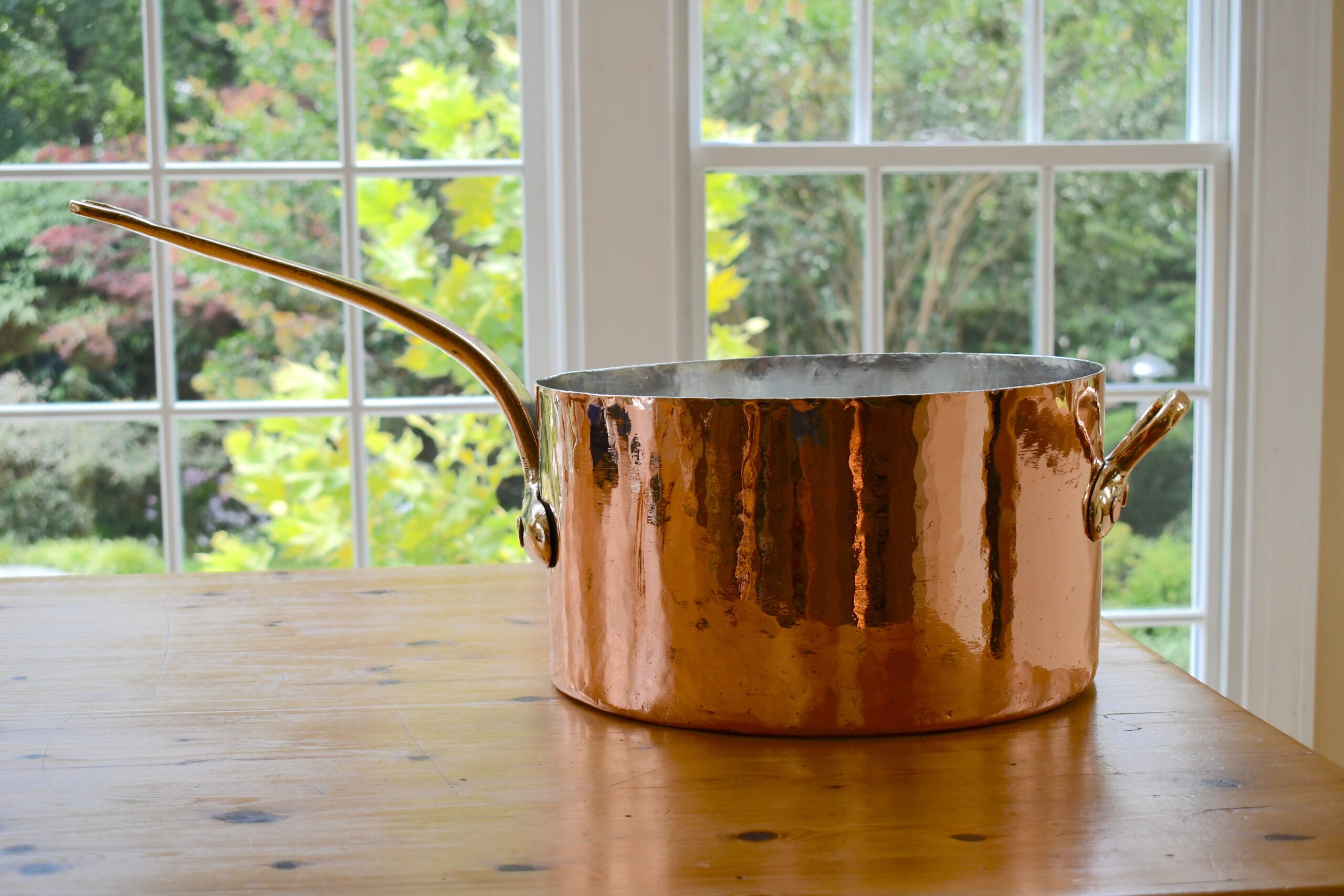
| Type | Tin-lined saucepan in hammered finish with brass stick handle and helper handle attached with three copper rivets |
| French description | Saucier martelé et étamé avec queue et poignée en laiton munies de trois rivets en cuivre |
| Dimensions | 34cm diameter by 19cm tall (13.4 by 7.5 inches) |
| Thickness | 2mm at rim |
| Weight | 8498g (18.7 lbs) |
| Stampings | SJC; BKS; 37 |
| Maker and age estimate | Unknown; 1900s-1910s? |
| Source | Etsy (France) |
I was intrigued by this big pot the moment I saw it. In my experience it is unusual to see a saucepan with a main handle made not of iron but instead of brass, which strikes me as an uncharacteristically un-pragmatic choice. Brass is far more conductive than iron and so a brass handle will heat up much more quickly than an iron handle of the same size and shape, and the French chaudronniers — a pragmatic bunch marketing to equally pragmatic French cooks — considered this when they selected the handles for their products. Pans that were frequently picked up and shifted around during cooking (such as sauté pans and saucepans) got stick-shaped iron handles that kept the pan’s heat from creeping up to the cook’s hand, while pans that were left stationary during cooking (such as stockpots, rondeaux, and stewpots) were fine with short side handles made of brass.

So how did this saucepan end up with a stick-shaped brass handle? One possibility is that it was intended as a serving piece, not a cooking piece. French cuisine considers the presentation of food to be a crucial component of its appeal, and so a kitchen might maintain one set of copper pans for the cooktop and a second to convey prepared and arranged food to the table to delight the guest. While the cooktop set was made of thick copper with each pan equipped with an iron or brass handle according to its purpose, the “table service” set was made of thinner copper (less than 2mm) and always fitted with brass handles for maximum visual appeal. (This pot is 2mm at the rim and perhaps a little thicker in the base, so it’s within the range of table service in my opinion.)
But this is a big pot. It weighs more than 18 pounds unladen and an additional 12 quarts of liquid — just two-thirds of this pot’s 18-quart capacity — would add 25 more pounds. I have a hard time imagining even the burliest waiter hauling this off the stovetop and staggering out of the kitchen and into the dining room to show it off to the guests.

Another possibility is that the pot originally had an iron handle and the brass handle is a later replacement. But I don’t see signs of re-drilled holes and the rivets look flat and era-appropriate. Rivets added later in the 20th century would have been smaller, with rounded mushroom-like factory heads.

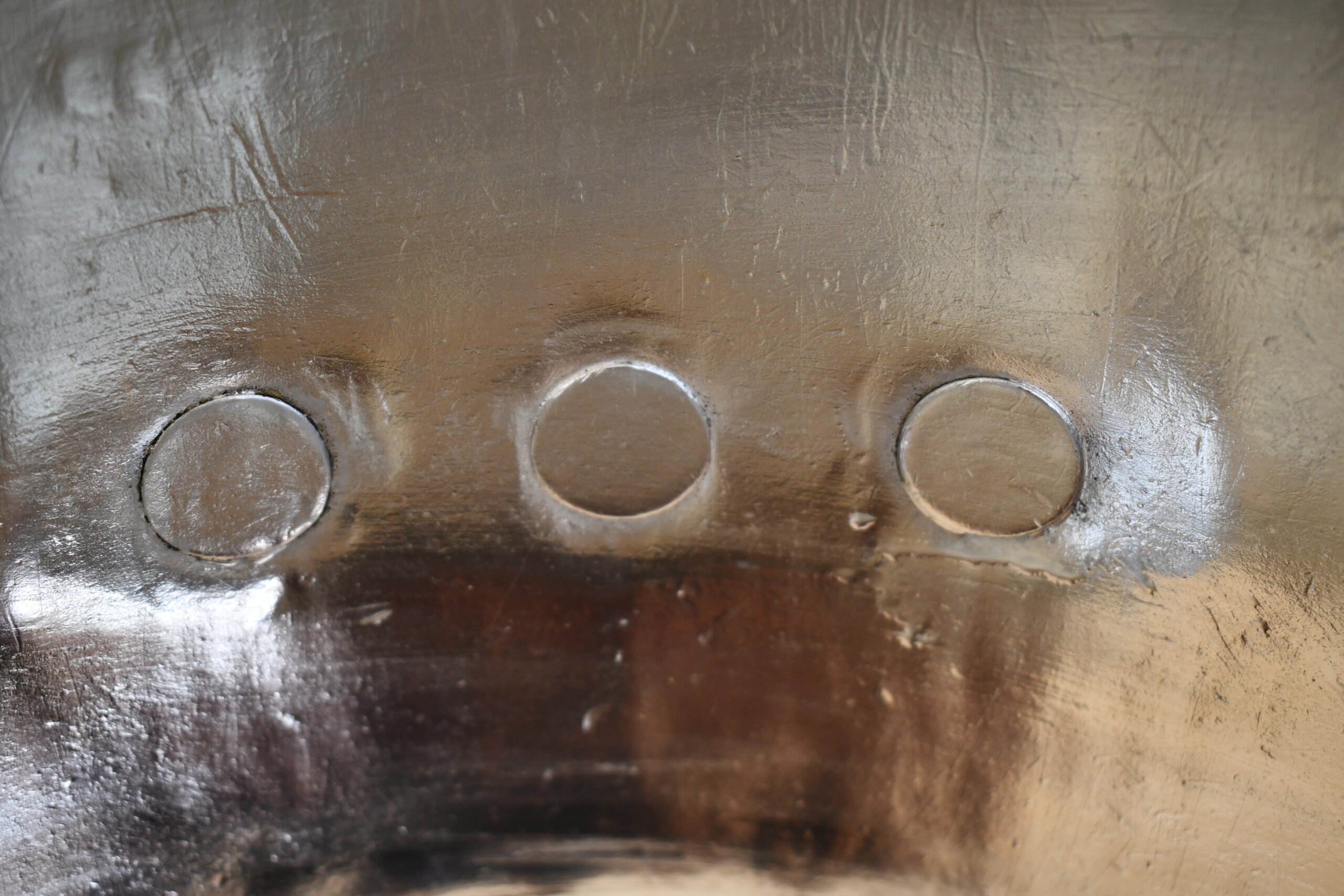

The interior and exterior rivets on the helper handle look almost identical, suggesting to me that both handles were put on the pot at the same time using the same methods.
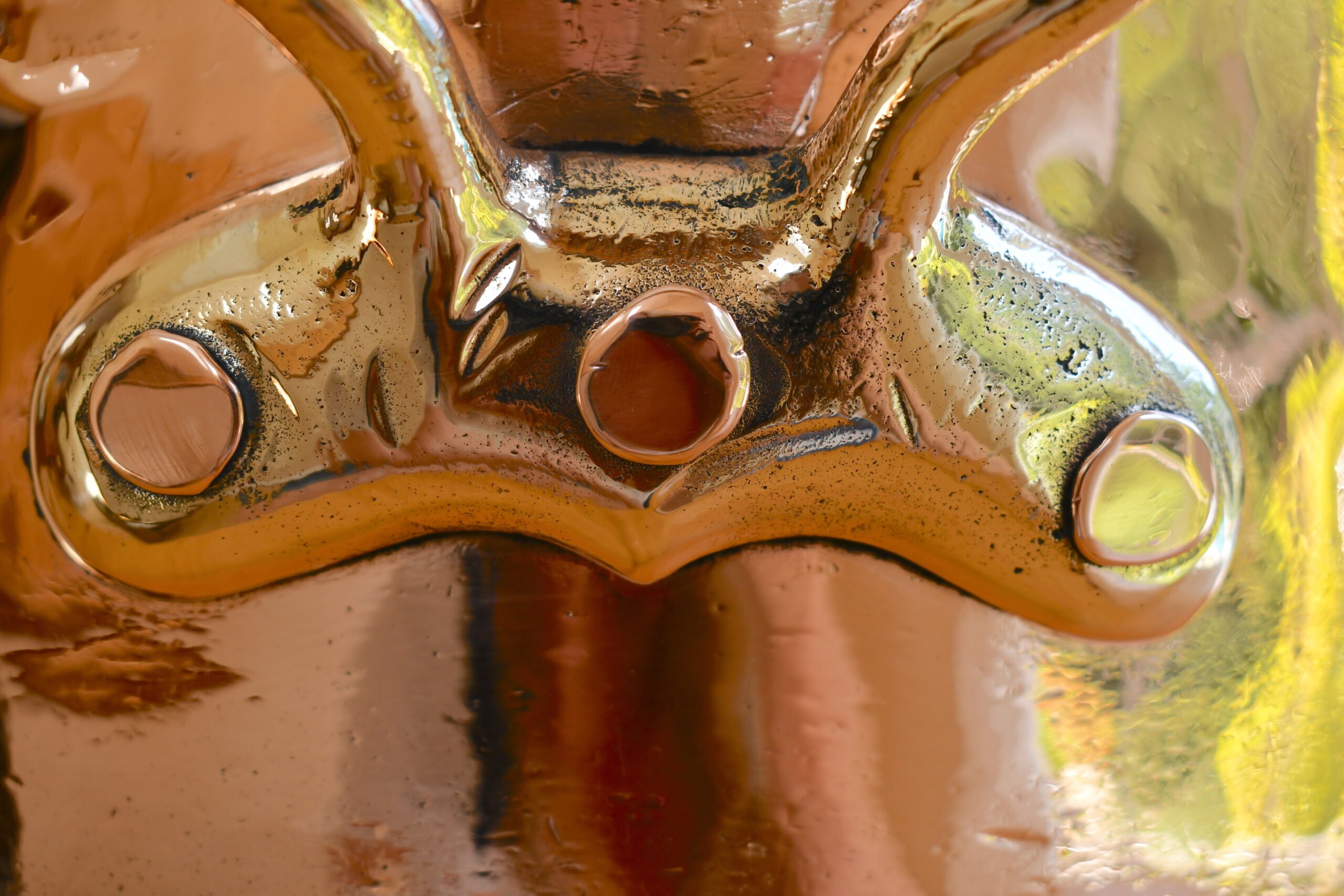
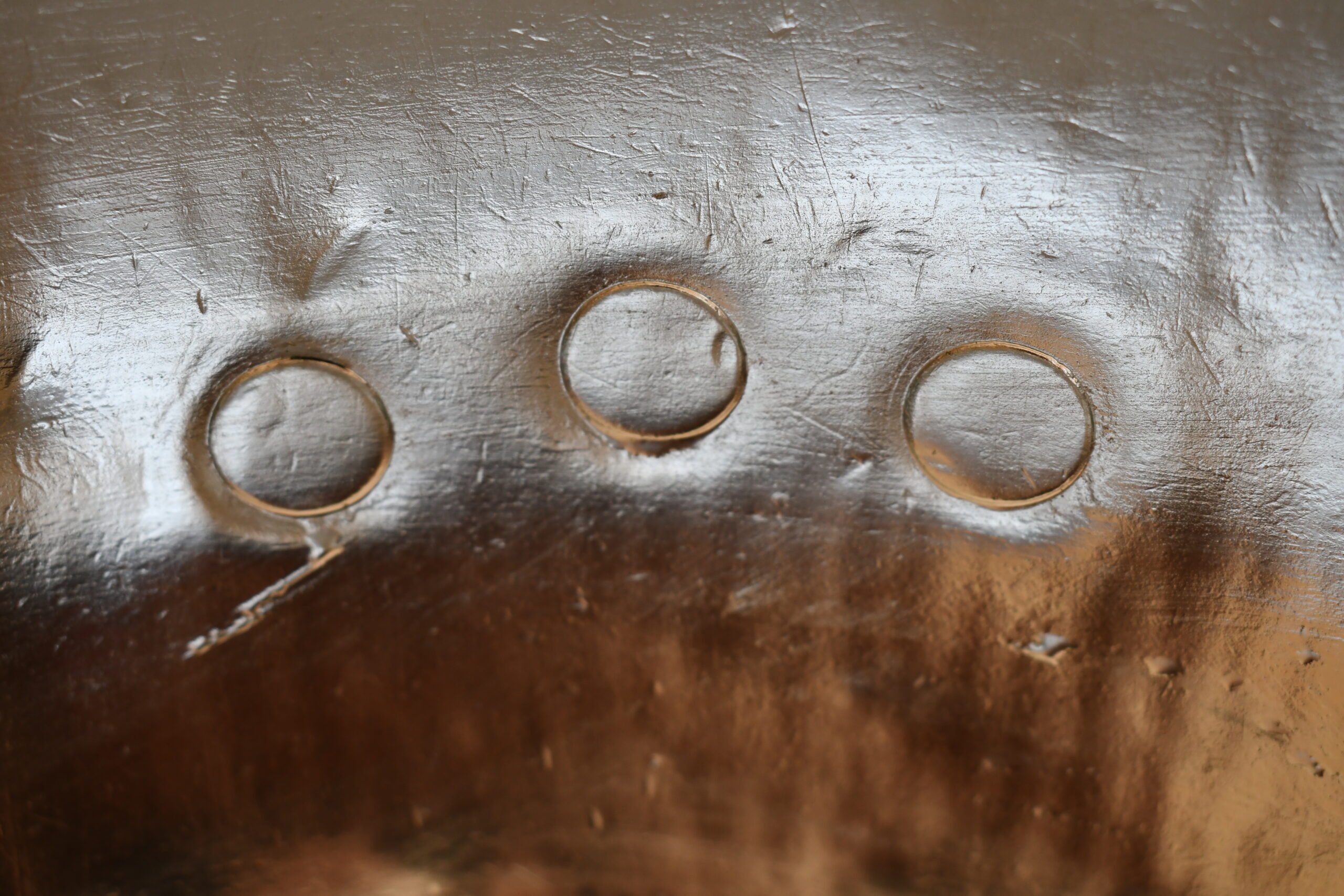
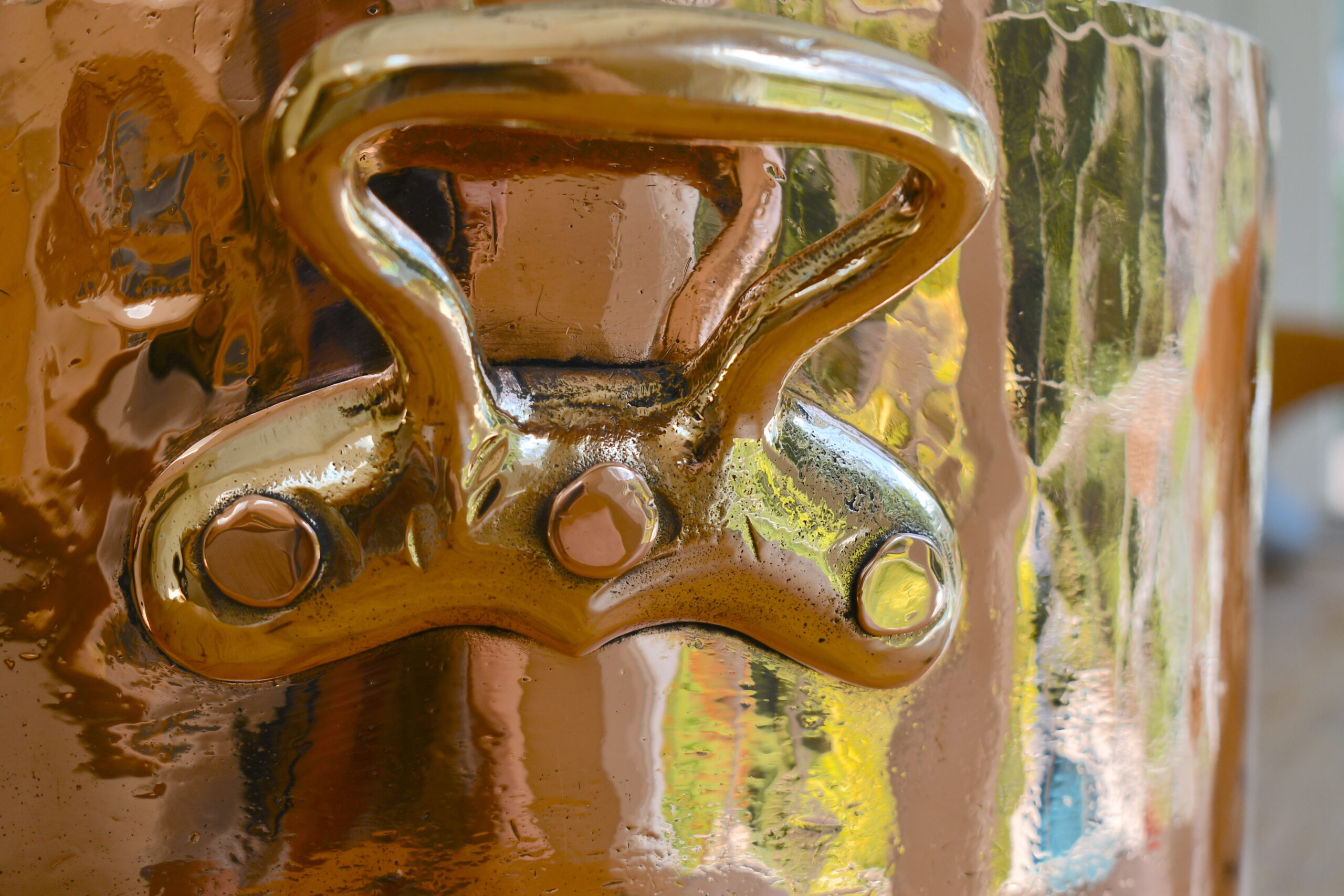
The long brass handle, unusual though it may be, is beautiful to me. While the upper plane of the handle is smooth, the underside is textured with scratches. It reminds me of an elephant’s trunk.
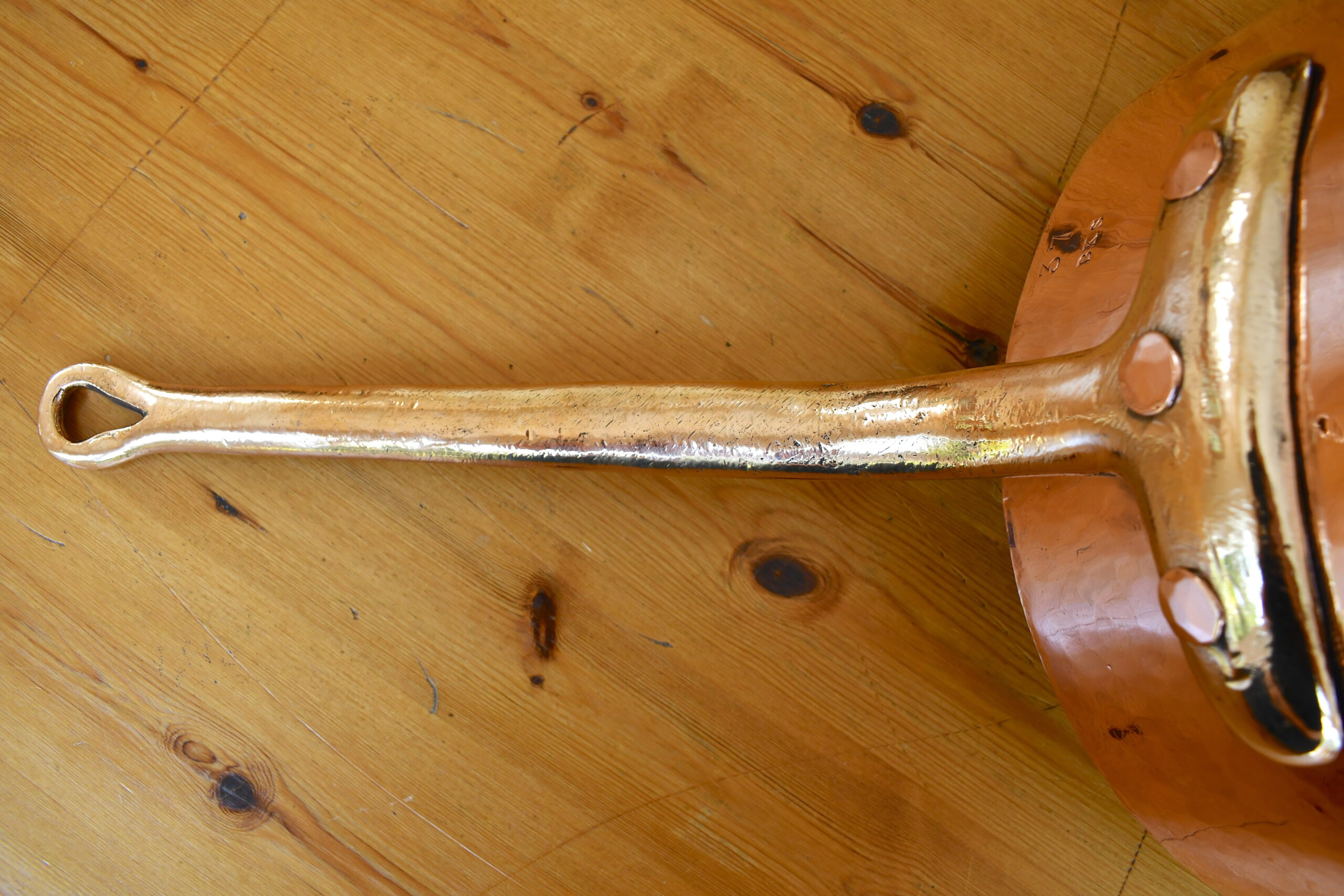
I thought brass handles were by necessity cast, but this one has the irregular shape of a wrought piece. Could this handle have been shaped by hand?
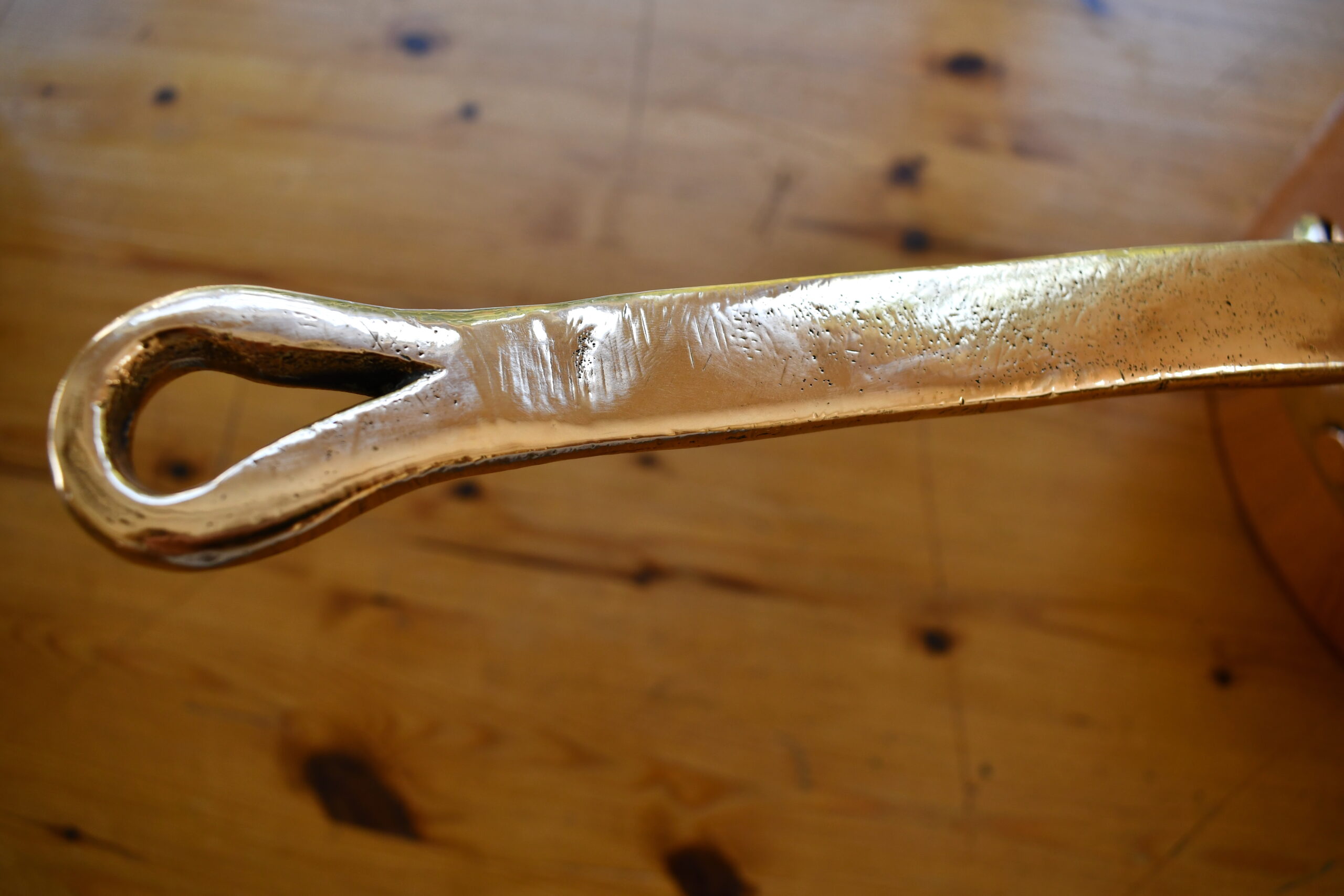


In addition to its all-brass hardware, this pot is also interesting for its construction. I expected it to be dovetailed: it has the sharp 90-degree return of a pot with sidewalls bent inward to join the base. But there are no tell-tale yellow lines of brazing to be found. I spent a few minutes looking carefully at it to figure out how it was made and I finally detected a very faint seam running around the floor of the pan about half an inch from the sidewall. It’s not a crenellated dovetail seam but a continuous circle. It’s difficult to capture in a photo but I managed to find one section that is visible.
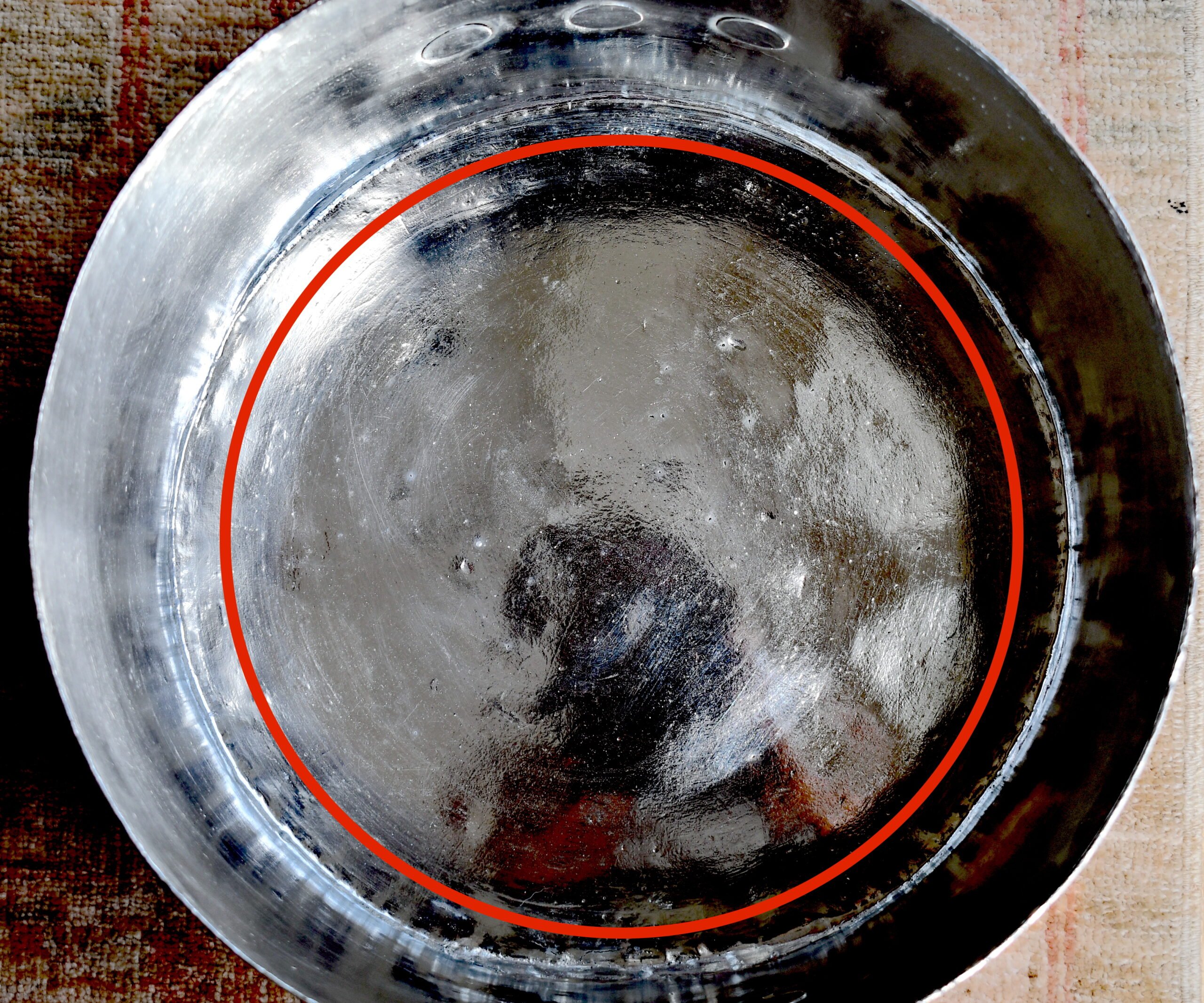
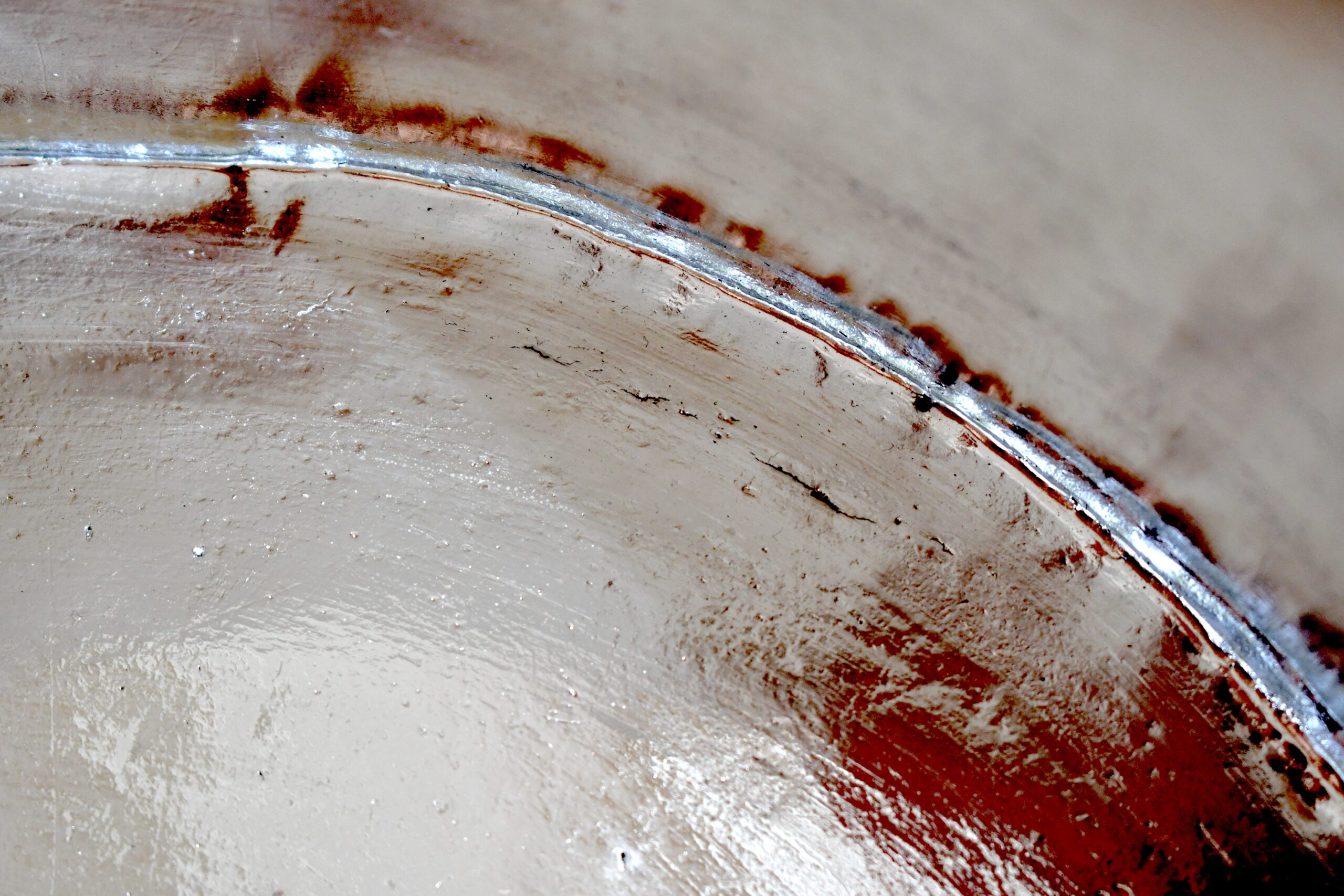
The outside base of the pan is seamless except for one tiny crack visible along the edge. As you can see in the photos below, there is no brass brazing.


Putting these clues together, I think this is pot was welded, perhaps a very early example of this technique in use for French copper cookware. It looks to me that the base is a flat disk and the sidewalls have a narrow flange folded inward and welded flat on top of it. I think this is why I expected to find dovetails — this pot was assembled like a dovetailed piece and that’s why it has the same distinctive sharp-edged 90-degree return.
This construction is unconventional for a welded piece and that’s why I think this is an early example. Deep pots like stockpots and daubières are welded to this day but the base is pressed into a cup shape while the sidewalls remain flat; if you look closely at a 20th-century stockpot or daubière you may be able to trace the weld seam running around the sidewall an inch or two above the base. I am not a metallurgist or materials scientist but this modern construction seems better to me because the weight of food in the pot applies force parallel to the join, seeking to slide it apart. In this saucepan, by comparison, the weight of food applies force perpendicular to the join, seeking to pop it off the bottom.
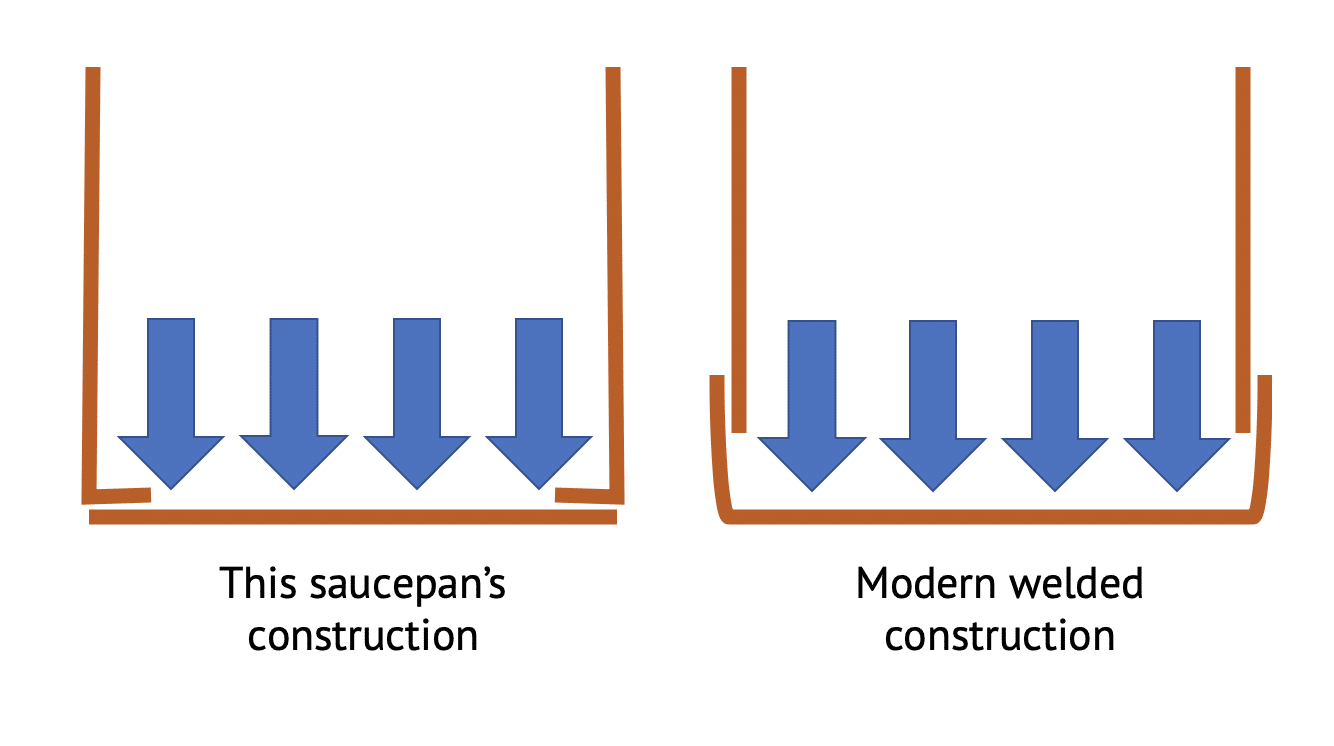
(If you must know, yes, I made this diagram all by myself using PowerPoint.)
The techniques of welding were discovered earlier in the 19th century but it did not become economically feasible for routine industrial use until the invention of the hand-held acetylene torch in France in 1901. Welding is much faster and easier than dovetailing and produces a much stronger join; the war effort accelerated the development of industrial welding for military and industrial use, and by the 1920s dovetailing had become largely obsolete in France. My guess is that this pot was made by a chaudronnerie still learning about welding, perhaps between 1901 and 1910 or so, before they realized that relocating the welding seam to the sides of the pot better managed strain on the join. But as always, I would love to hear from people with better experience and knowledge — what do you think?
There’s another advantage of moving the join away from the edge of the pan: it’s less likely to be damaged. On big pots and pans like this, the bottom edge opposite the main handle is the spot that strikes surfaces first when it is moved around, and consequently here is where you are most likely to find dents and cracks. This pot did not escape this fate: there is a dent on the base underneath the helper handle right on the welded seam, and the seam has cracked. This pot was restored for me by Erik Undiks at Rocky Mountain Retinning and he performed a beautiful subtle repair with brass braze.
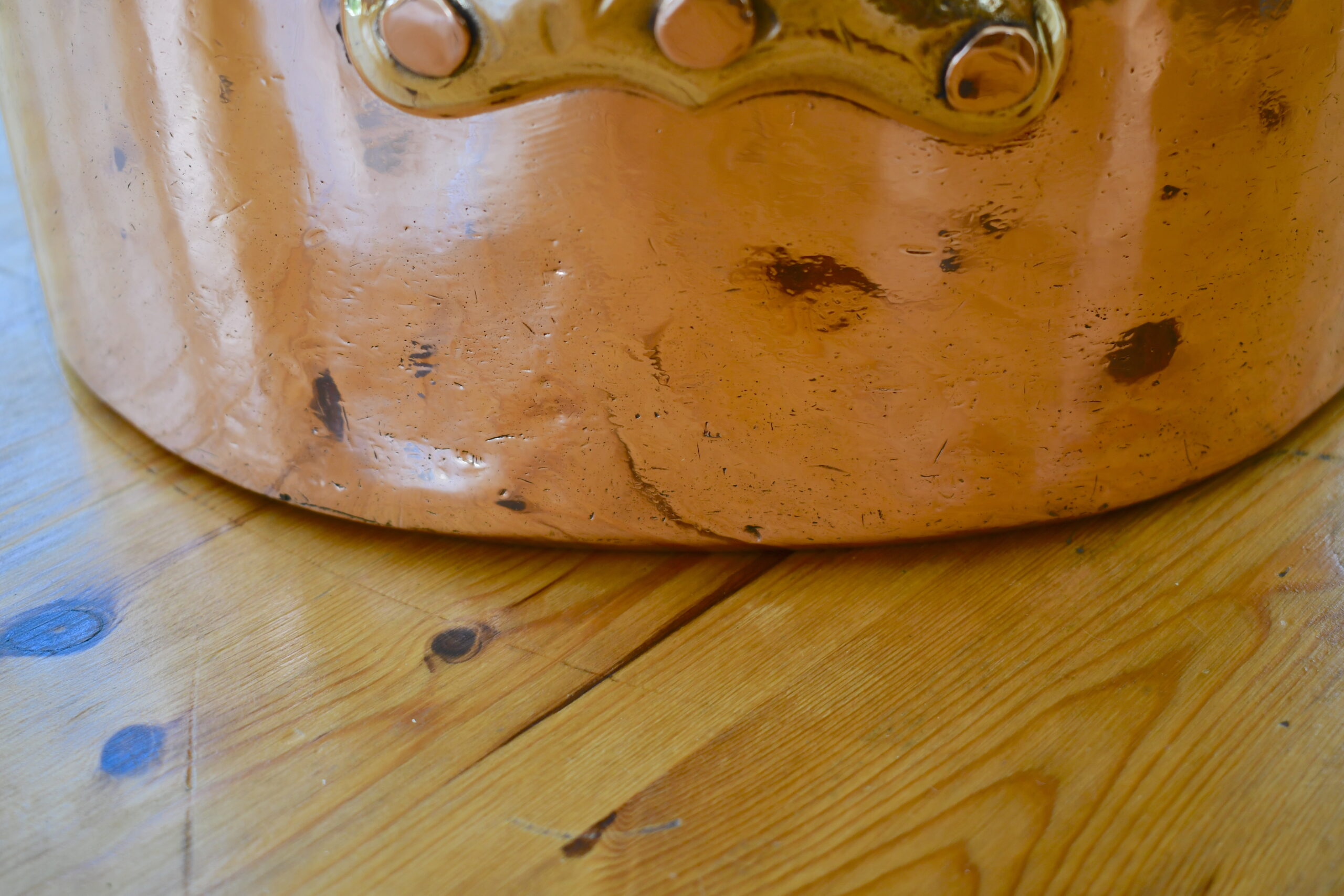
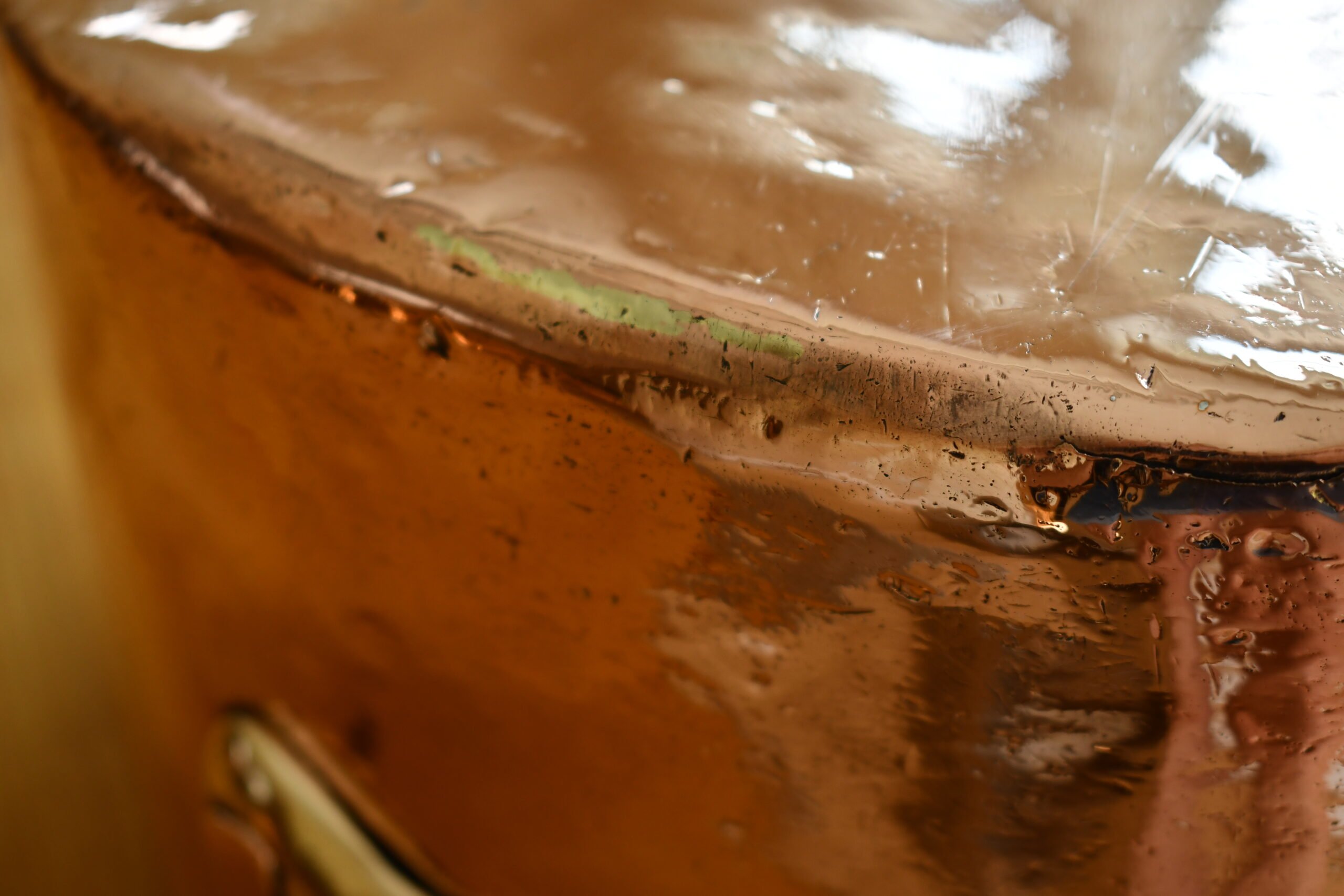
A little ironic, isn’t it, that the modern welded seam ended up being fixed with old-fashioned brass a hundred years later!
As above I think I know when this pot was made — between the early 1900s to as late as 1910 or so — but I don’t know who made it. I have reason to believe it’s of French origin: I bought the pot from an Etsy seller in France and the handle styles are both in the French manner down to the teardrop shape of the stick handle’s hanging loop. But beyond that, I don’t have a clue.
The pot has no maker’s mark but does have two groupings of stamps that I think are owner’s marks: “37” and “BKS,” and in a separate area, “SJC.” I don’t know what these stand for but based on the typefaces I suspect the more ornate BKS is earlier than the SJC, which looks like a mid-century typeface. I am not sure what the 37 means — the pot is a little over 34cm in diameter, but nowhere close to 37cm!
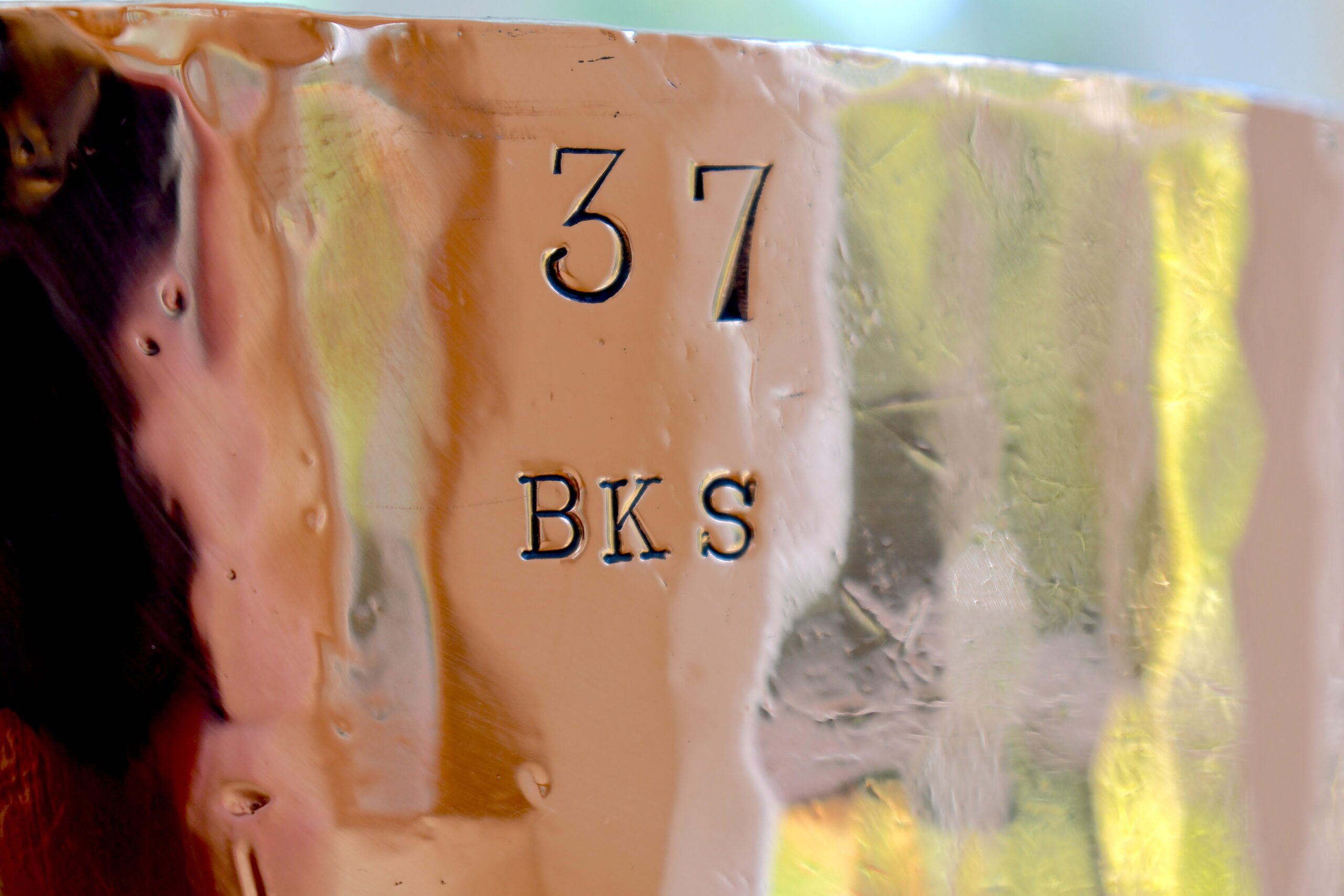
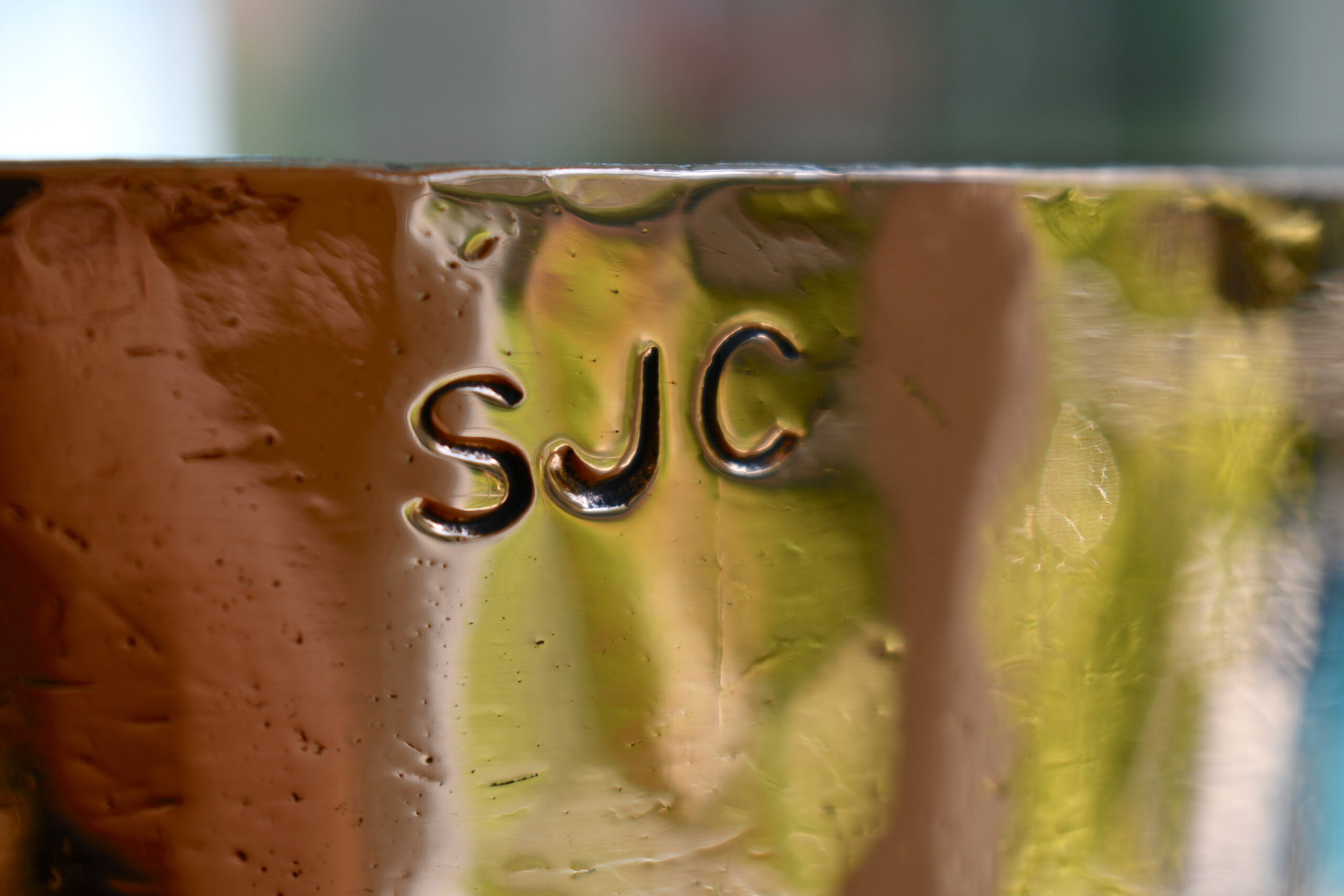
So what do you think of this quirky pot? A custom order, perhaps, for a restaurant that for its own reasons wanted a brass-handled saucepan, no matter how hot it got? A one-off experiment from a chaudronnier still learning how to place welded seams? I’d love to hear your thoughts, especially if you’ve seen more like this one and can help me identify it.






An beautiful and interesting pot, photographed very attractively.
As much as I appreciate the elegance of brass handles, one should never forget that they get hot as hell very quickly. But at the latest after a blister, you will always be aware of it. For shorter handles, I use a protection that is pushed onto the handle. I handle longer handles with an oven glove or something similar.
I also suspect that the pot served primarily for representative purposes when serving. To date, Mauviel has a range of pans and pots on offer, also made of thinner copper and with handles made of brass, which are intended for use at the table. The heavy pot had to be lifted from time to time, but I assume that a stable trolley was available for transport from the kitchen to the dining room.
The long handle has a shape similar to the handle of my Jaeggi bain marie or my soup pot. The base plate of the Jaeggi handle is less wide according to the smaller dimensions of my pot. The handle is also corrugated on the underside. Since brass is usually very smooth and slippery, this slight roughness gives more security when touching and moving the pot. I noticed that the design of the counter grip is a bit more “baroque” and therefore typically French than the factual design of the main grip, which looks comparatively “British”. But overall the design of the beautiful pot looks French.
My Smith & Matthews saucepan 26cm forgive me for forgetting it completely. Its brass handle is even more similar to the pot presented here. With one difference: the S&M has a round eyelet for hanging, therefore not the typical French teardrop shape.
Hi, another beautiful pan. I have a couple with brass??Handles and they don’t seem to get particularly hot. It would be an interesting experiment to heat similar pans with a thermometer attached and see what the real world difference is. I see those handles described as bronze and as bell metal.
Martin – I think that Smith and Mathews were a retailer and your pan was almost certainly made by Benham and sons whose cast handles have a drilled hole and with a completely flat upper surface. Only produced for a short time before “T” shaped handles similar to Birmingham Brand were used.
I have a brass-handled saute pan which I bought from a seller in France through Etsy. The pan shows early construction having that compass point in the center of the pan bottom. It measures 36cm in diameter with a thickness of 3mm and weighs a hefty 4.84 kg (10 lbs. 10 oz.) and so is a serious cooking pan. It shows a hammered finish to both sides and bottom, has a typical keyhole opening at the handle tip and there are no stampings on the pan.
Roger, unfortunately I could hardly find out anything about S&M during my research, so thank you for your information. In my profile post there are several photos of the saucepan. S&M describe themselves as coppersmiths, as their stamp shows. Maybe they were initially until they found selling easier. You are right, the upper part of the handle is completely flat. Overall, the handle is less curved than is known from French handles. The small chaudronneries probably didn’t make the handles of their pans themselves, but bought them. Therefore you can find very similar handles on different brands of pans. I only use 3 pans with long brass (or bronze) handles, two English by Jaeggi and one French by Cerdon. I was told that Jaeggi used bell metal as the handle material. The handles of the small pans get so hot just by making a scrambled egg that I can no longer touch them with my bare hands. Unfortunately, I don’t have a suitable thermometer to measure the temperature objectively.
Martin, I have taken another look at the pan in your profile picture, I have seen a similar one with both the S and M stamp and Benham and sons (also a railway pan if I remember correctly). Benham and sons were manufacturers who supplied everything for hotels and restaurants including furniture and linen. Dredging my memory, responsible for fitting the Reform Club kitchen and the galley of HMS Discovery for Captain Scott (don’t quote me without checking). There does not seem to any information on Smith and Mathews. I have a saucepan like yours and a 12″ saute + a 10″ one stuck in transit (covid-19) all with the same handle and unmarked. These handles often turn up bent unlike Leon Jaeggi which survive well. Take my attribution as a lead for research rather than fact.
Due to some irregularities in the main handle, which suggests manual production, VFC raises the interesting question of whether the handle may have been “wrought” on which unfortunately no one has commented yet. In the German original from 1888 of “Handbuch der Schmiedekunst” (Manual of Blacksmithing) by Prof. Meyer, which VFC discovered in an English translation from 1896 (!) and thankfully sent a PDF-version to me, “wrought” is equated with “forged” (both “geschmiedet”). The distinction between seems to be an Anglo-Saxon specialty. If I refer to the original manual, the activity itself is referred to as “Schmieden” (“forging”), the result as “Schmiedeeisen” (“wrought iron”). The German word “schmiedbar” is translated as “malleable”. You see, German is a simple language. Small variations of a single word replace two words in English.
To come back to the question from VFC. Another fairly complex textbook from 1992, which I am currently studying with great difficulty, only describes that brass (and bronze) can be cold (e.g. bowl, jug) and hot formed (e.g. pipes, sheets, wires, profiles) and both alloys are very suitable for casting. Theoretically, it would be conceivable that a brass handle can be forged. However, if no traces of hammering remain visible afterwards, an elaborate finishing polish would be required. The effort for this should be much greater than if the handle is cast. Especially since many nearly identical copies can be made with one mold. So I tend to assume that the mold or the casting process itself was not perfect and resulted in slight irregularities. At that time it wasn’t unusual.
I looked for synonyms for “wrought”:
constructed, elaborated, fashioned, formed, made, manufactured, molded, processed, shaped, worked, machined, finished, constructed.
Only the combination “wrought iron” refers clearly to “forging”.
It is therefore difficult for me to imagine that “wrought” should describe its own metalworking technique. But I like to be instructed otherwise.
Martin, you’re coming across a linguistic ambiguity with which I continue to struggle: in English metalworking vocabulary, “wrought iron” and “wrought iron” are two different things. That is, there is a type of iron called “wrought iron” as well as finished products that are “wrought iron.” My separate post “Forged, wrought, cast” has become caught in this and I am, as we speak, taking a step back to consider how best to bring it back to soundness — a sort of annealing, I guess you could say. I can’t reconcile the differences in terminology between English and German (more the pity) but I will do my best to be clear in the language that I have.
Brass does not behave like steel in that it must be cold worked. A sheet of brass can be bent or raised into a hollow vessel but it rapidly work hardens and will crack if not regularly annealed by heating and traditionally quenched in vinegar to keep it bright though natural air cooling is also fine. Never attempt to straighten a bent brass handle without annealing.
Brass lends itself to casting, there are plenty of cast brass saucepans about because making them was a cheaper less labour intensive process than making copper pans and the heat conductivity will be similar, much better than cast iron. Not sure I want to cook in unlined brass though.
This handle on this pan is cast and nicely finished.
Roger, I agree that the handle most certainly has been cast. And yet, the hanging loop is imperfect and shares the taffy-like appearance of a grained wrought handle. Could the loop have been heated and gently coaxed into shape?
It is more likely that a hand made wrought iron handle was used as the master from which this was cast. It is possible that the pan was dropped and the handle bent in use then rectified at the next tinning. Bending /straightening cast brass is a high risk procedure and often near enough is better than breaking the thing in pursuit of perfection. Looks to have been polished a lot of times resulting in a pleasingly rounded edges.
At that time, casting was not as perfect as we imagine it to be today. Neither making a master mold, nor the alloys, nor the casting itself. Why should a handle have suffered less over time than the pan? None of us is surprised by crooked and irregularly hammered floors, a flattened hammer pattern, tens of dents, thousands of scratches, loose rivets and the traces of repeated re-tinning and polishing. On the contrary, many even appreciate these traces of an eventful life. This nameless sauce pan is wonderful as it is!
Martin, an eBayUK vendor has just listed a Benham stamped Windsor with a handle I think matches your
S and M pan.
Roger, certain alloys of brass can be formed both hot AND cold. The English term is “wrought alloys”, the German term “Knetlegierung” (translated literally “kneadable alloy”).
The most effective thermoforming process is extrusion. So-called semi-finished brass products such as rods, but also pipes, profiles and wires are manufactured here. Brass sheets are probably hot rolled. The hot-formable brass alloys are of course also suitable for forging.
I suspect brass pans were thermoformed (deep-drawing) rather than cast. At least that would make sense since pans made in this way would be less fragile and it would be more economical. But I do not know.
Thanks, Roger, you are right. The handle and the hammering pattern are very similar tomy S&M saucepan.
I have been thinking about this and the evolution of Benham handles which may also apply to the French pan.
Coppersmiths had to have a forge before gas equipment was available to to braze joints and tin interiors. It is reasonable to suppose that some wrought their own handles in house. When cast handles came in those who used them were at a competitive advantage.
Casting iron requires very high temperatures, a job for a proper foundry. Casting brass is something you can literally do that in your backyard and when you already got a forge well why not?
Brass handles – in house production, but not really tough enough for commercial kitchens and cast iron became really cheap with mass production.
Roger, very good thoughts almost as if from personal experience! Indeed, the melting temperatures make the difference.
I have never cast brass but I remember watching a YouTube video of a guy casting a bronze skillet using an iron one as a pattern. Seen plenty of kinked brass handles on Benham pans.
Roger, I was just kidding, but YouTube is also an experience. I’ve watched a lot of videos about casting lately. Mostly, the liquid metal was poured into a mold by hand, other casting processes in the industry were fully automated. The manual pouring looked amazingly simple (I know it’s not!), like scooping a thick soup from a large stock pot and then pouring it into a plate. I was amazed at how little protective clothing the craftsmen wore and how routinely and casually they worked with the liquid metal. So I can well imagine that this process could be carried out in a similar way in smaller workshops over 100 years ago.
The organization of the craftsmanship should still be considered.
From the Middle Ages until industrialization in the 19th century, the union of master craftsmen and merchants was known as a guild. The guild law applied in cities, outside of which the craft was guild-free. Guilds were always institutionally limited to the individual craft. Outside the guilds, the guild profession was not allowed to be practiced. The guilds controlled the number of craftsmen and journeymen (assistants) in the cities and laid down their rules in writing in officially approved guild regulations. Important decisions depended on the approval or goodwill of the authorities. Guilds had a monopoly on the work to which they were privileged.
It can therefore be assumed that a master who had permission to produce copper pans in his workshop was not allowed to make castings. In this regard, he was dependent on suppliers. In French I know the terms “dinandier, chaudronnerie, la fonderie”, whose activities overlap in part, but also complement one another.
TJ could certainly say more precisely how the craft trades that primarily interested us were organized and worked together.
Up until the 20th century, there were almost a dozen highly specialized professions in Germany that worked in metalworking. A redsmith or brassmith had his special field of work, which differentiated him from a coppersmith. To this day, the remaining professions are represented and organized by guilds (“Innung”). The manufacture and tinning of a copper pan is only allowed to a coppersmith, related professions such as boilers, plumpers, sheet metal workers etc. are not allowed to do this.
By the way: the well-known French actor Gérard Depardieu was born the third of six children of a tin smith.
Currently a J.Gaillard Saute Windsor 26cm (stamp 1920-30) is offered on ebay.fr, which has a handle that is quite unusual. It is strongly reminiscent of handles like those of certain English pans. That means the handle is straight and quite angular, it has a round eyelet and a comparatively angular base plate. As a counterpart, my photo collection contains pictures of Benham & Sons pans that had handles with teardrop and keyhole eyelets and corresponding softer handle shapes that are common for French pans.
The manufacturers of copper pans in these two countries have apparently temporarily equipped their pans with handles that are unusual for them. What are the reasons for this? Was this a special contract work for a foreign country? Were certain handles not available at a time and were you content with alternatives?
In any case, one could hypothesize that coppersmiths cooperated with suppliers for handles.
I have to add: Since the handle of the Windsor was sloppy mounted (see rivets on the inside of the pan), it could have replaced the original handle at a later date.
Benham are usually round hole.
Usually, I know. But why are there other designs?
I have an unstamped Windsor with a drop shaped hole, assumed it was by a different maker but maybe not.
Long story short: my photo collection of pans contains a large variety of handles and combinations, mostly they are typical for the respective manufacturer (or supplier) of the pans, but sometimes completely untypical. Sometimes you can explain the difference with the long and eventful history of some pan manufacturers (or supplier), sometimes not. Everyone likes to figure it out for themselves.